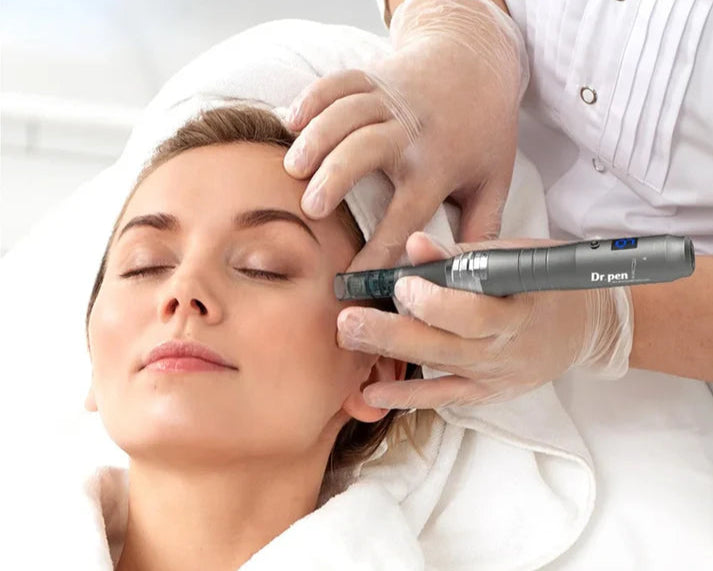Microneedling, a popular skincare procedure, has gained significant traction in recent years due to its effectiveness in addressing a variety of skin concerns such as fine lines, wrinkles, scars, and pigmentation. This minimally invasive technique involves using a device equipped with tiny needles to create micro-injuries on the skin's surface, stimulating the body's natural healing process and promoting collagen and elastin production. One of the key components of a successful microneedling session is the selection of the right serum to use in conjunction with the microneedling pen. The right serum can enhance the procedure's results, providing nourishment and targeted treatment to the skin. However, choosing the appropriate serum can be overwhelming with the myriad of options available. This article outlines the factors to consider when selecting serums to use with a microneedling pen.

Understanding the Role of Serums in Microneedling
Before diving into the selection process, it's crucial to understand why serums are used during microneedling. The micro-channels created by the needles allow for deeper penetration of active ingredients found in serums. This means that the skin can absorb these ingredients more effectively, enhancing their benefits. Serums typically contain a high concentration of vitamins, antioxidants, peptides, and other beneficial components that can address specific skin concerns.
Factors to Consider When Choosing Serums
1. Skin Concerns
The first step in selecting a serum is identifying your skin concerns. Are you looking to reduce fine lines and wrinkles, improve skin texture, fade scars or pigmentation, or address acne? Different serums are formulated to target specific issues. For instance, a serum rich in peptides and hyaluronic acid may be ideal for anti-aging, while one containing vitamin C can help with brightening and evening out skin tone.
2. Ingredients
Understanding the ingredients in a serum is vital. Here are some key ingredients to look for based on your skin needs:
Hyaluronic Acid: Excellent for hydration and plumping the skin.
Peptides: Stimulate collagen and elastin production, aiding in skin firmness and reducing fine lines.
Vitamin C: Brightens the skin, reduces pigmentation, and protects against environmental damage.
Retinol (Vitamin A): Promotes cell turnover, improving skin texture and reducing signs of aging.
Antioxidants (such as vitamin E, green tea extract): Protect the skin from free radical damage and inflammation.
Growth Factors: Accelerate healing and tissue regeneration, beneficial for wound healing and scar reduction.
Ensure that the serum you choose contains ingredients that align with your skin goals. However, it's important to note that some ingredients may not be suitable for everyone. For example, retinol can be irritating, especially for those with sensitive skin.
3. Skin Type
Your skin type plays a significant role in determining which serum will work best for you. Those with dry skin may benefit more from hydrating serums containing hyaluronic acid, while oily skin types might prefer serums that help control oil production and minimize pores. Combination skin may require a balanced approach, and sensitive skin types should opt for gentle, non-irritating formulas.
4. Formulation
The formulation of the serum is another critical aspect. A well-formulated serum should be free from harsh chemicals, fragrances, and preservatives that can irritate the skin, especially post-microneedling when the skin is more susceptible to sensitivity. Look for serums that are specifically designed to be used with microneedling devices, as they are often formulated to be less irritating and more easily absorbed.
5. Molecular Weight
The molecular weight of the ingredients in the serum affects their ability to penetrate the skin. Smaller molecules can penetrate deeper into the skin, making them more effective. When choosing a serum, consider one with a blend of both small and large molecules to ensure both deep penetration and surface hydration.
6. Compatibility with Microneedling
Not all serums are created equal when it comes to microneedling. Some ingredients, such as acids (like glycolic or salicylic acid), can be too harsh for post-microneedling skin and may cause irritation or inflammation. It's essential to choose a serum that is compatible with the microneedling process and won't compromise the skin's healing.
Tips for Using Serums with a Microneedling Pen
Consult a Professional: Before starting any microneedling regimen, consult with a skincare professional. They can assess your skin and recommend the most suitable serum for your needs.
Patch Test: Always perform a patch test with the serum before using it with a microneedling pen. This helps to ensure that you're not allergic to any of the ingredients.
Follow Instructions: Carefully follow the instructions provided with both the microneedling pen and the serum. Overusing the pen or applying too much serum can lead to adverse effects.
Start Slow: If you're new to microneedling, start with a lower needle depth and gradually increase it as your skin becomes accustomed to the treatment. Similarly, use a milder serum initially and progress to more potent formulas as needed.
Moisturize: After microneedling, the skin may feel dry and tight. Apply a hydrating moisturizer to soothe the skin and support the healing process.
Sun Protection: Post-microneedling, the skin is more sensitive to the sun. Always wear a broad-spectrum sunscreen with an SPF of at least 30 to protect your skin from UV damage.
Conclusion
Choosing the right serum to use with a microneedling pen can significantly enhance the results of your microneedling sessions. By considering your skin concerns, ingredients, skin type, formulation, molecular weight, and compatibility with microneedling, you can select a serum that addresses your specific needs and promotes healthy, radiant skin. Remember to consult with a skincare professional, perform a patch test, and follow the instructions carefully to ensure a safe and effective microneedling experience. With the right serum, you can maximize the benefits of microneedling and achieve your skincare goals.

Share:
Can a Microneedling Pen Help with Age Spots?
Microneedling Pen for Dark Circles Under the Eyes